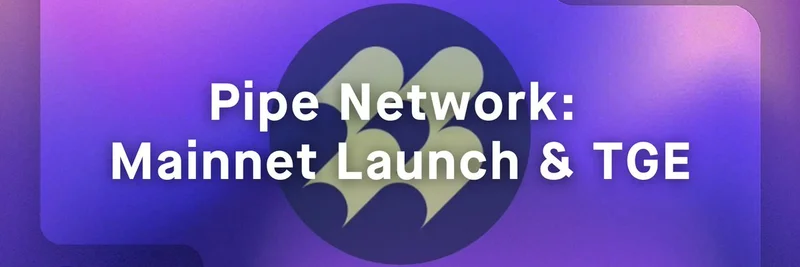If you're into blockchain and decentralized tech, you've probably heard the buzz around DePIN—Decentralized Physical Infrastructure Networks. These projects aim to disrupt traditional centralized systems by leveraging crypto incentives and community participation. Today, we're diving into Pipe Network, a promising player in this space that's just launched its mainnet and PIPE token. This comes straight from a recent thread by Nick Carpinito, a research analyst at Blockworks, who broke down the key details.
Launch Timeline and Core Features
Pipe Network officially went live with its mainnet on October 8, 2025, at 15:00 UTC, coinciding with the Token Generation Event (TGE) for its native PIPE token. For those new to the term, a TGE is basically the initial release of a project's cryptocurrency, often marking a major milestone.
What sets Pipe apart is its focus on building a decentralized Content Delivery Network (CDN). Traditional CDNs, like those from Cloudflare or Akamai, speed up web content delivery by caching data closer to users. Pipe takes this concept and decentralizes it, using a global network of nodes to provide better geographic coverage and potentially lower costs.
As of launch, Pipe boasts around 290,000 nodes deployed worldwide. That's a massive distributed setup! Security-wise, it integrates with Jito's restaking protocol on Solana. Restaking here means reusing staked assets to secure multiple networks, boosting efficiency and yields. This positions Pipe to compete head-on with legacy CDN providers by offering superior distribution and resilience.
Innovative Architecture: Responsive CDN and Storage
At the heart of Pipe is its "Responsive CDN" architecture. This system runs sealed-bid Vickrey auctions every two seconds to price bandwidth dynamically based on real-time network conditions. Vickrey auctions? Think of them as second-price auctions where the winner pays the second-highest bid—it's a game theory favorite for fair pricing without overbidding.
Complementing this is Firestarter Storage, which launched back in September 2025. Together, they form a full-stack alternative to centralized giants like Cloudflare, handling both delivery and storage in a decentralized manner. This could mean faster load times for dApps, websites, and media, all powered by blockchain.
PIPE Tokenomics: Burn-and-Mint Model
No crypto project is complete without solid token economics, and Pipe delivers with a burn-and-mint equilibrium design. Here's the breakdown:
Inflation Schedule: Starts with a 12% nominal inflation rate in year one, but the realized rate is about 6.18% after accounting for burns.
Usage Mechanism: Content consumers burn PIPE tokens to acquire "Data Credits," which they use for CDN services and storage.
Node Rewards: Operators only earn PIPE when they provide verifiable bandwidth, proven cryptographically. This ensures the network rewards actual contributions, not just participation.
This model creates a flywheel: more usage leads to more burns, which can stabilize or even deflate the token supply over time. It's usage-gated disinflation, meaning inflation slows as the network grows.
Key Milestones and What to Watch
Post-launch, the team and analysts like Carpinito are keeping an eye on several metrics to gauge success:
Latency improvements: How much faster is content delivery compared to traditional CDNs?
Enterprise adoption: Will big players validate and integrate Pipe's tech?
Burn rates: Early data on how many PIPE tokens are being burned through usage.
These will be crucial for Pipe's long-term viability in the competitive DePIN landscape.
For a deeper dive, check out the full Blockworks Research report here. And if you want to see the original thread that inspired this article, head over to Nick Carpinito's post on X here.
Pipe Network's launch could be a game-changer for decentralized infrastructure, especially in the Solana ecosystem where memes and high-speed apps thrive. Whether you're a node operator, developer, or just a crypto enthusiast, keeping tabs on projects like this can give you an edge in understanding the next wave of blockchain innovation. What do you think—will Pipe disrupt the CDN market? Let us know in the comments!



